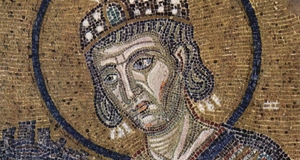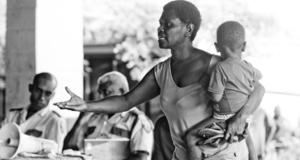Religion in Caribbean Literature
By
2009, Vol. 1 No. 11 | pg. 1/1
KEYWORDS:
The language of religion plays an important part in the novels Brown Girl, Brownstones; The Farming of Bones; and In the Time of the Butterflies. In Brown Girl, Brownstones, the author presents the intricate Silla as a woman who is weary of her work and calls on the “Lord” for “power” (Marshall 224). In The Farming of Bones, poignant symbols of hardships faced due to ethnic cleansing rest in examples such as the pronunciation of the word perejil and the religious value of Massacre River. In the Time of the Butterflies describes the lives of the Mirabal sisters in a language interspersed with the names of Catholic saints, an important part of their daily life, their culture. In these three texts, the authors use religion as a defining element of the language that describes and preserves the characters’ journeys through the world of their cultures. Throughout Brown Girl, Brownstones, Silla is continually referred to as a hard-working woman. Her religious views seem to indicate a heavy emphasis on works. She initially appears to possess an unbreakable will, always bearing a constant look of determination, “the resolute mouth, the broad nose, the bold yet well-molded contours of the bones under her deeply browned skin” (Marshall 22). Later, however, she admits the psychological and physical fatigue she feels over knowing that she will always be working. Paule Marshall presents Silla as the quintessential Bajan. Silla demonstrates the Barbados culture in her every action: “her +endurance, her rage, her devotion to the dollar and property, her determination to survive in ‘[this] country’ is theirs” (Washington 315). Though Silla’s work is tiring, she must continue on to preserve her culture. Silla’s very life is an epic-like tale in itself, describing the Barbados culture. When she is at her weakest point in forming the epic, she cries out “Lord, lemme do better…lemme rise!”(Marshall 224). Using religious references, she pleads for strength from a higher power in an action that acts as the invoking of the Muse. She must turn to a higher power for the ability to continue her life, the creation of an epic-like account of her culture.The metaphor of cleansing appears frequently in The Farming of Bones. Both water and parsley serve as items sought for the religious procedure of cleansing. Often included in religious ceremonies was the practice of purging one’s self: “[parsley] was used as an emetic” (Grieve 764). The practice of shibboleth refers to using the particular pronunciation of a word to distinguish which individuals are members of a particular group and which individuals are outsiders. Shibboleth originates from the Bible. In Judges, the Gileadites struck down the Ephraimites, and then took control of the Jordan River. Whenever someone attempted to cross, the Gileadites would ask him to say shibboleth, and if “he said ‘sibboleth,’ [because] he could not pronounce it correctly, […] they seized him and slew him at the fords of the Jordan (NIV, Judges 12). Similarly, during Rafael Trujillo’s dictatorship, he used perejil as a linguistic device to distinguish the difference between the French-speaking Haitians and Spanish-speaking Dominicans. The perejil symbolizes not only actual cleansing, but the ethnic cleansing that took place partially based on language. The name Massacre River combines two significant elements—history and religion—of Haitian and Dominican culture in its words. Massacre, though eerily predicting the death of the fugitive Haitians, actually refers to the past historical event of a “separate massacre in the nineteenth-century of French soldiers by revolting native slaves” (Elek). River includes the religious properties of water. Voodoo and Christianity mention water as natural elements rich in symbolism. Water possesses a dual purpose, often used as a metaphor for both life and death. In Christianity, water is used as a “symbol of death and burial, life and resurrection” (Elek). In Voodoo, “spirits can be summoned through any type of natural water” (Elek). These “spirit[s] of the rivers” consist of varying qualities—such as the goddess Lasiren—as capable of comforting mortals as luring them to their deaths (Danticat 50). Edwidge Danticat seems to use the idea of a dual-purpose religious symbol to further a predominant theme in her novel: the necessity of preserving memories. Previous to the more recent massacre, the Haitians took part in the religious properties of the water with no memory of the blood that spilled from the previous massacre, a warning embedded in the language—the name—of the river. Even after the 1937 Massacre, Danticat visited Massacre River and noted that people were still using it, completely having forgotten its past. Recognizing the tendency to forget what history is not recorded, she realized the importance of writing the tale of the 1937 Massacre in a language rich with religious metaphors. In her novel, Danticat centers the plot on Massacre River, the best way to relate to Haitian and Dominican culture in terms of religion and history. The novel describes the drowning of Amabelle’s parents, her father crying out to the Voodoo “spirit of the rivers” (Danticat 50) as he plunges into its depths, and the deaths of the Haitians pursued by the ethnic cleansers to the “river of our blood” (Danticat 212). The river seems to predominantly symbolize death until the very end of the novel. Amabelle journeys to the river again and describes herself as resting in “water so shallow that [she] could lie on [her] back in it with [her] shoulders only half submerged” (Danticat 310). At this point, a type of baptism—a renewal—appears to take place as Amabelle decides “to go on living” (Danticat 309). This baptism revitalizes her by connecting her to the memories of lives lost, the memories of “[her] father’s laughter, [her] mother’s eternity” (Danticat 310). In order to keep on living, she remembers her culture’s history through a tangible relic of the religious aspect of her culture. In order to allow others to better understand the importance of remembering, Danticat creates a written account of Haitian and Dominican history and culture that uses religious symbolism to emphasize life and death as resulting from remembering and forgetting. The novel In the Time of the Butterflies describes the Dominican version of Trujillo’s rule. The Mirabal sisters—Patria, Dede, Minerva, and Maria Teresa—were born in Ojo de Agua around the time Trujillo was first elected as President of the Dominican Republic. In the novel, each of the protagonists detail the limitations placed on their freedom of speech. Eventually, Trujillo identifies the church as a place where the Dominicans rally and gain strength. Taking this into consideration, he places further limitations on the church, even attempting to desecrate places of worship. Trujillo’s regime hires prostitutes to make lewd gestures during services, encourages assassination attempts on the Archbishop, and declares the church to be an enemy of the state. The church resorts to many methods in retaliation. For instance, the nuns at the convent hide Hilda from Trujillo’s men, and Padre de Jesus assists Las Mariposas in transporting weapons. Frequently, the characters in the world of the text must resort to coding to transmit messages of importance and religious encouragement. Within their own writing, the characters Patria, Dede, Minerva, and Maria Teresa refer to a particular saint every time they wish to express a particular thought or feeling. Patria Mirabal’s reference to Saint Bernadette seems to predict the sister’s future. Saint Bernadette was a pious youth who was told by the Virgin Mary to dig in mud until healing water appeared. Similarly, Patria seems to be aware that her calling—to leave the convent—is imminent as she pours water over the feet of those entering the church. Saint Dominic is known for the idea that communities should be centered on the church. The mention of Saint Dominic in Alvarez’s In the Time of the Butterflies seems to refer to a wish for their community to be built around the strong and uncensored presence of the church as it was in pre-Trujillo times. On November 25, 1960, Trujillo’s men brutally murdered Las Mariposas. The three sisters became the posthumous advocates for the Elimination of Violence Against Women. In the novel, the Mirabal family servant Fela is described as building a shrine to the deceased sisters and claiming to speak to Las Mariposas through Voodoo. Though Fela is discouraged from continuing her alleged communications, Alvarez seems to hint at the three sisters’ status: because of what they accomplished, Las Mariposas have become uncanonized saints. Las Mariposas have become an indelible part of language and legend; they have become words used to signify dedication to a pure cause. Religious references incorporated into everyday language describe an important theme of the novels Brown Girl, Brownstones; The Farming of Bones; and In the Time of the Butterflies. Silla calls on the “Lord” for “power” as if she were invoking a Muse to provide her with strength while she continued her life’s story (Marshall 224). Amabelle emphasizes the importance of remembering history through mentions of religious symbols, such as the river and its corresponding “spirit[s]” according to Voodoo (Danticat 50). The Mirabal sisters describe their thoughts and feelings by using saints’ names as a type of code to counter the censors enacted by Trujillo’s regime. In each of these three texts, the authors use religion as a defining element of the language that describes and preserves the characters’ journeys through the world of their cultures. ReferencesAlvarez, Julia. In the Time of the Butterflies. New York: Plume, 1995. Danticat, Edwidge. The Farming of Bones. New York: Penguin Group, 1999. Elek, Jordan. “‘Reflecting’ on the Symbolism of Water in The Farming of Bones.” Universal Journal. 2004. AYJW. 16 April 2009. Grieve, Margaret. A Modern Herbal. Vol. 2. Mineola: Dover Publications, 1971. Marshall, Paule. Brown Girl, Brownstones. New York: The Feminist Press, 1981. The Holy Bible, New International Version. Nashville: Broadman & Holman, 1995. Washington, Mary Helen. “Afterword.” Brown Girl, Brownstones. New York: The Feminist Press, 1981, 311-324. Suggested Reading from Inquiries Journal
Inquiries Journal provides undergraduate and graduate students around the world a platform for the wide dissemination of academic work over a range of core disciplines. Representing the work of students from hundreds of institutions around the globe, Inquiries Journal's large database of academic articles is completely free. Learn more | Blog | Submit Latest in Literature |
















